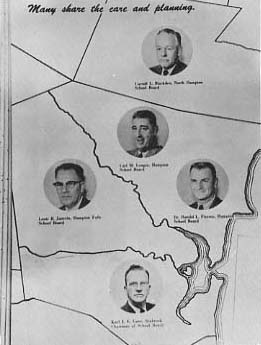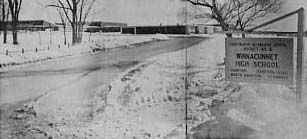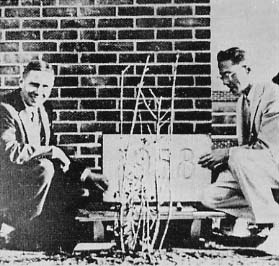Hampton Academy & Winnacunnet High School Alumni Association
65th Anniversary, Historic Souvenir Booklet, 1972
Back to previous section — Forward to next section — Return to Table of Contents
By Harold L. Pierson, D.M.D., New Hampton, N.H.
Explosive growth patterns, affecting the entire Seacoast Region during World War II, created serious spatial problems in Supervisory Union No. 21 when the rising population trends continued unabated with the cessation of hostilities. A remarkable yearly growth rate of 25 per cent resulted in over-crowding school after school within the seven-town school Union. Only one of the seven school districts had a high school — Hampton Academy and High School. The need for additional space to educate Seacoast students on the secondary level became acute.
The late Roy W. Gillmore, Superintendent of Schools at the time, was quietly planting the seeds for a joint venture — a cooperative high school that could serve the entire Union. In 1958, Exeter High School and Hampton Academy announced that their schools were so overcrowded that they could no longer accept tuition pupils from North Hampton and Hampton Falls. Amesbury High School raised its tuition rates for Seabrook students and refused any long-term contract, leaving the town of Seabrook dangling on a limb. South Hampton — only three miles from Amesbury and with very few students had no interest in joining a cooperative. New Castle and Rye preferred to send tuition students to Portsmouth High School, where they had closer socio-economic ties.
A study committee was appointed in 1956 by Alden E. Loberg, Chairman of Union 21 to examine the possibilities of forming a cooperative secondary school district. The committee included Philip M. Toppan (H.A. & H.S. ’35), Hampton; Robert W. Weaver. Hampton Falls; Herbert G. Bridges, North Hampton; and Mrs. Jean K. Gove, Seabrook. John C. Thorp represented New Castle and Stanley P. Batchelder, Rye,
Superintendent Gillmore retired in 1958 and was replaced by Dr. Edward C. Manning, whose dynamic leadership was one of the must important factors in creating the Cooperative District. He researched and prepared much of the information; motivated the Study Committee and the local school boards into publicly supporting the new concept: and made endless personal appearances. The late Edward S. Seavey, Jr. ’32, Publisher and Editor of Hampton Union, threw full support of his weekly paper behind the project, publishing an informative series of eight articles which were later condensed into a single brochure for distribution to every voter.

Hampton Union photo from the “Sachem,” 1959)
With such advance planning, the concurrent meetings that were held in the four towns on January 18, 1957, voted unanimously to petition the State Board of Education for permission to form a cooperative school district. The vote, at the Hampton meeting was 113 to 3; Hampton Falls, 46 to 0; North Hampton, 48 to 11; and Seabrook, 56 to 20. Just three days later — January 21st — the State Board approved the petition and issued n call for an organizational meeting to be held on March 28, 1957.
At this meeting, the citizens of the four towns voted 307 to 17 to form a cooperative. It, also, elected a school board of five members – two from Hampton and one each from the other towns. In order to establish an orderly, succession of membership on the Board and to maintain continuity, it was decided prior to the vote that the individual receiving the most votes would have a five-year term and so forth down the line. The original School Board was composed of Harold L. Pierson, D.M.D.. of Hampton, five years: Carroll L. Blackden, North Hampton, four years; Karl J.E. Gove, Seabrook, three years: Carl M. Lougee, Hampton, two years; and Louis B. Janvrin, Hampton Falls, one year. Alden E. Loberg was elected moderator and Mrs. Florence D. Haley was named Clerk pro tem.
At this point in time, the Cooperative Secondary School District No. 6 had a School Board but no school. It did have a mandate to select an architect, determine a building site and proceed at once to develop plans for a new high school. Official approval of the petition was made by the State Board on April 15, 1957. The Board then organized formally, electing Karl Gove as Chairman and Dr. Harold L. Pierson, Secretary. Mrs. Florence D. Haley was appointed Clerk and James F. Leavitt ’06, Treasurer. Both Mrs. Haley, of Seabrook, and Mr. Leavitt, a North Hampton native, have served in those capacities to the present time. John W. Perkins ’20 was named as legal counsel.

Work immediately began with the selection of the firm of Tracy and Hildreth of Nashua as architects and Dr. Nicholaus Englehardt, Jr., of New York as educational consultant. Only ten weeks after its official formation, the School Board held a meeting on July 1st at which the voters approved the purchase of a 52-acre site on Landing Road in Hampton and by a vote of 85 to 2 authorized the borrowing of $1,350,000 to construct a high-school building. On October 8, 1957, the low hid of $1,183,244 was awarded the Harvey Construction Company of Manchester. Ground-breaking ceremonies were held 22 days later. Only five months after the district was formed, construction had been started. During construction, Harold Brown of Rye served as “clerk of the works” for the School Board.
With construction of the new high school proceeding rapidly, the following spring — March 6, 1958 — the voters passed an initial budget of $33(1, 151 and at the same meeting chose the Indian word — Winnacunnet, meaning “beautiful place in the pines” — as the official name of the new school they had just funded. In April, the Board announced that Edmund A. Tanzi, former assistant principal at Valley Stream High School on Long Island, had been chosen headmaster.
In the fall of 1958, Winnacunnet High School opened its doors to 474 students — only two years after a study committee had been appointed to investigate the idea. This miraculous speed reflects great credit on the voters of the four towns who moved from an idea to a complex reality in an unbelievably short space of time. Winnacunnet was officially dedicated in an impressive ceremony on October 26, 1958
At the time the original study was made the projected growth figures were considered by many as unrealistically high — but the enrollment estimates turned out to be low. In six years, the number of students rose from 474 to 840 making it necessary for the School Board to propose an addition since the original building was designed with a capacity for 750. Fortunately, the Board had had the foresight to plan for this contingency by providing basic heating, power and water for a 1200-student building and designing a building that made provision for addition. The first request for an addition was defeated in 163 but a bond issue of $642,000 was voted in 1964 for construction of an addition that would increase the size of the building to hold 1200 students.
Now, in 1972 — fourteen years after Winnacunnet opened its doors — this capacity figure is rapidly becoming a reality and the district will have to make some hard decision concerning spatial needs. However, philosophical changes in secondary education will provide citizens with a number of alternatives when the time comes for decision-making. The voters and the School Board — currently consisting of Chairman Russell A. Merrill ’44, Karl J. E. Gove, D. Malcolm Hamilton ’30, John A Trumbull ’47 and Edgar N. Hobby, Jr. — will have to consider those alternatives. Open campus, year-around school, modular scheduling, decentralization, and other ideas will alter the traditional ways that space is being used in education.
Educationally, Winnacunnet has enjoyed an excellent “track record.” Over the years, the educational achievement has been enormous. The school has met community needs by keeping pace with educational change. Curriculum that is fresh and meaningful is updated from year to year. Technological progress is carefully researched and evaluated before being used in the system. As former Principal Daniel S. Maloney once said, “We can never afford the luxury of accepting last year’s curriculum to meet next year’s needs.”

Since its formation, Winnacunnet has had three Principals. Edmund A. Tanzi, who was the first Headmaster, resigned after two years to return to teaching in New York. Daniel S. Maloney, who replaced him served the school impressively from 1960 to 1968, when he made the decision to leave educational administration to work in evaluation of secondary schools and colleges on the New England regional level. Eugene R. Hawley has been serving Winnacunnet as Principal since 1968.
My own ten years’ association with Winnacunnet between 1957 — when I became a Board member with no school building — and 1967, when I left the Seacoast for the Lakes Region of New Hampshire, has filled me with many pleasant and satisfying memories. It, also, provided me with lots of friends in and out of education. Having participated in the conception and birth of Winnacunnet, one has to feel like a proud parent.
At the age of 14 and with 1130 pupils, Winnacunnet is still a “baby” compared to the 333-year history of the Hampton area. But those 14 years have been honorable and significant in the progressive growth and development of the youth of the area. Also, numberwise, Winnacunnet has already provided secondary education to more students in those few years than did Hampton Academy and High School in all of its historic and important existence. Winnacunnet has a bright and important future.
O! stone that in thy place doth symbolize
The strength and rectitude of walls above.
From thy true face give inspiration wise
May all who see thee in the years to come,
When glad reunions make the echoes ring.
Still hold thee as the guardian of the home
Of Alma Mater, whose dear praise they sing.
–John F. Merrill

The total cost of the completed 1958 building, 52-acre site ($54,000) and its preparation, architect’s fee, and equipment ($75,000) was $1, 359, 753. It now takes that amount to merely operate the school (with additions) for a single year.
WINNACUNNET HIGH SCHOOL
Hampton, New Hampshire
DEDICATION EXERCISES
Sunday, 3:00 P.M.
October 26, 1958
— PROGRAM —
Superintendent Clarence M. Green, Presiding
MUSIC
Peg Norton, Organist
INVOCATION*
Reverend Matthew Casey
Our Lady of the Miraculous Medal Church, Hampton
ADVANCE OF COLORS*
The Hamptons’ Legion Post #35
The Raymond E. Walton Pst #70, Seabrook
PRESENTATION OF KEYS
Paul H. Harvey, President and Treasurer
Harvey Construction Company
TRANSFER OF KEYS
Stephen P. Tracy
Tracy & Hildreth, Architects
ACCEPTANCE OF BUILDING FOR DISTRICT
Karl J. E. Gove
Chairman, School Board
INTRODUCTION OF GUESTS
Headmaster Edmund A. Tanzi
INTRODUCTION OF SPEAKERS
Dr. Edward C. Manning
Superintendent of Schools
Pearl River, New York
Honorable Lane Dwinell
Governor, State of New Hampshire
Dr. William G. Saltonstall
Principal, Phillips-Exeter Academy
RETREAT OF COLORS*
The Hamptons’ Legion Post 35
The Raymond E. Walton Post #70, Seabrook
BENEDICTION*
Reverend Everett R. Scruton
First Baptist Church, Hampton Falls
MUSIC
Peg Norton, Organist
4:00 – 6:00 P.M. – – – – – – – – – – – – – – – – – – – – – – – Inspection of Building
* Audience will please stand.

(Hampton Union Photo from the “Sachem,” 1959)